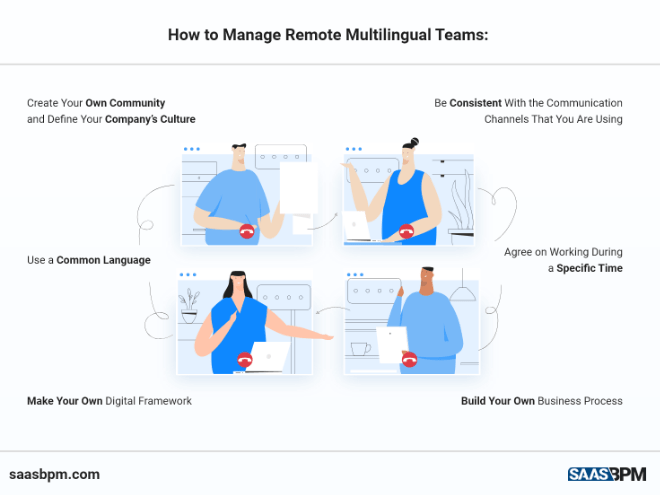
Six Tips To Properly Manage Remote Multilingual Teams
With the digital and technological power that we all have in our hands today, it’s no wonder that remote work is taking over a lot of companies and businesses. It is incredibly useful, especially since the whole world is currently battling a pandemic.
However, remote work can present a few challenges, especially if not done the right way. Things can get even more complicated if you are working with a remote multilingual team. In this article we will discuss what you can do to make sure that you will be properly managing your remote teams when they are also multilingual.
What Are Remote Multilingual Teams?

Remote multilingual teams are a group of people who are working from different places. They can be located in different cities or even countries. If they live in different countries, then most probably the team is multilingual – meaning they speak different native languages.
This usually also means that they have different cultures and beliefs. Additionally, most remote multilingual teams work in different time zones.
Working with a remote multilingual team can be a bit of a challenge, but with the right rules and the right BPM system in place, it is definitely possible.
How to Manage Remote Multilingual Teams
Now that we have defined what remote multilingual teams are, it is time to suggest how you can properly manage your own team.
Use a Common Language
Speaking in more than just one language can cause confusion and communication issues across the team. It gets even more complicated if you decide to keep documentation in several languages and use tools in those. So when you build your team and choose software and tools, make sure to choose one language that everyone in the team is speaking. Make that language mandatory for new hires.
English is the universal language, and using it to communicate with your teammates will help make the process a lot easier and better. This avoids creating an environment that is non-inclusive, which can make certain team members feel like they are an outcast. Make sure to use this language every time you are speaking to the whole team so nobody will get left behind.
If you currently have a team member who is having a hard time speaking the common language that the team is using, then try offering language courses to them. You can also try getting a translator for the meantime to make things a lot easier for them.
Create Your Own Community and Define Your Company’s Culture
Most of your team members might have been brought up from different cultures, but that doesn’t mean you cannot define your own culture within the company. Most workplaces have a culture of their own, but since you do not have a physical office to do so, you should create a sense of community among the team.
You can use video-conferencing tools for meetings or get-togethers. This will give a sense of togetherness and make your team feel closer to each other. Schedule a catch-up meeting where you can talk about the work that you’ve done for the week and another one for personal chats. If possible, you can also schedule annual meetings in person to really cement your company’s culture.
Using a BPM in place can also help with the communication issues within the team. You all have to be on the same page, and SaaS BPM can definitely help you with defining your company’s community and culture.
Make Your Own Digital Framework
The best way to keep your remote multilingual team organized is to create a solid digital framework within the team. Determine the tools that you’d want to use and stick with those tools. Invest in useful ones such as Google Docs, Slack, Zoom, Trello, and SaaS BPM to make sure that your team will be able to work in an efficient way.
Choose one official language for all tools and stick to it. By arming your team with the right tools, you can be sure that the team’s productivity will increase no matter the location of each one.
Be Consistent With the Communication Channels That You Are Using

Since we are on the topic of using tools to keep the team updated, we have to mention this tip. You definitely have to be consistent with the communication channels that you are using to avoid confusion within the team.
Everyone in the team should be kept in the loop and no one should be left behind. Communication in itself can be a challenge due to different languages used within the team, which is being consistent with the tools that you use is utterly important.
Everyone should receive the same information and should be given the chance to participate in decisions when it comes to projects and assignments. Make sure to give them access to the communication channels that the team is using so that no one will be left behind.
Remember: it is always better to over communicate rather than under-communicate, especially when it comes to remote multilingual teams.
Agree on Working During a Specific Time
If you have team members from different parts of the world, then it is highly likely that you are working in different timezones. To make things easier for everyone, you have to make sure that you will agree on working during a specific time.
If this is not possible and the time zones are too far apart, then you should at least see to it that every team member will update on the communication channels after each shift. This will help avoid confusion and duplication of tasks within the team.
Build Your Own Business Process
Now that we have established that communication is key to managing a remote multilingual team, it is time to mention this tip. You have to build your own business process to make sure that your team will be more productive. Distractions are a huge roadblock when it comes to working from home, and creating your own process will help eliminate this.
This is the importance of using a BPM in place – to make sure that everyone stays on the same page. SaaS BPM will help you visually organize your projects and empower your team to make sure that projects will be done on time.
Conclusion
Working with a remote multilingual team is definitely possible as long as you do it right. Keep these tips in mind and see your team and company grow in no time!
This article was originally published in SaaS BPM.


